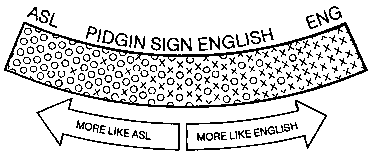Pidgin Sign English in the Deaf Community
ASL plays a very important role in the Deaf Community. It enables effective and intimate person-to-person communication; it shows that a person is part of the Community; and it helps to identify the Deaf Community from the rest of society.
However, the vast majority of parents, teachers, doctors, speech therapists, counselors, psychologists, religious workers, and employers that contact and work with Deaf people are hearing speakers of English who do not know ASL. So what do these Deaf and hearing people use to communicate with each other? Most often, they interact with each other through the use of Pidgin Sign English - a combination of certain elements of both ASL and English.
A pidgin is a language which develops naturally when people who do not know each other's language wish to communicate with each other. Normally, the pidgin is no one's native language. It typically combines certain vocabulary items and structures from the native languages of the people in contact with each other, and thus has a different grammar than either of the native languages. Pidgins are used all over the world. A linguist named David Decamp (1971) estimates that 2-3 million people use some form of pidgin every day in at least some language situations.
Pidgin Sign English (PSE) does not have one specific
set of rules. Rather, there are many forms of PSE. The forms used by Deaf
people tend to include more of the structures found in the grammar of ASL
(e.g. verb directionality) and less of the grammatical forms of English
(e.g. definite and indefinite articles: `the' and `a').
Conversely, the forms of PSE used by hearing people tend to include
more English grammatical structures (e.g. use of the verb `to be'), more
transliterations of English idioms (e.g. `to come across') and little of
the structures found in ASL. As a person's signing skill moves from English
to ASL, there are different stages which become less and less like English
and more and more like ASL. The opposite is true as a person's signing
moves from ASL to English. Thus, there exists a continuum of PSE varieties-some
more like ASL, others more like English. This can be illustrated in the
following way.

"Pidgin Sign English in the Deaf Community" from American Sign Language by Charlotte Baker-Shenk and Dennis Cokely. Drawing by Frank A. Paul. Washington, D.C.: Clerc Books, 1980. p. 73